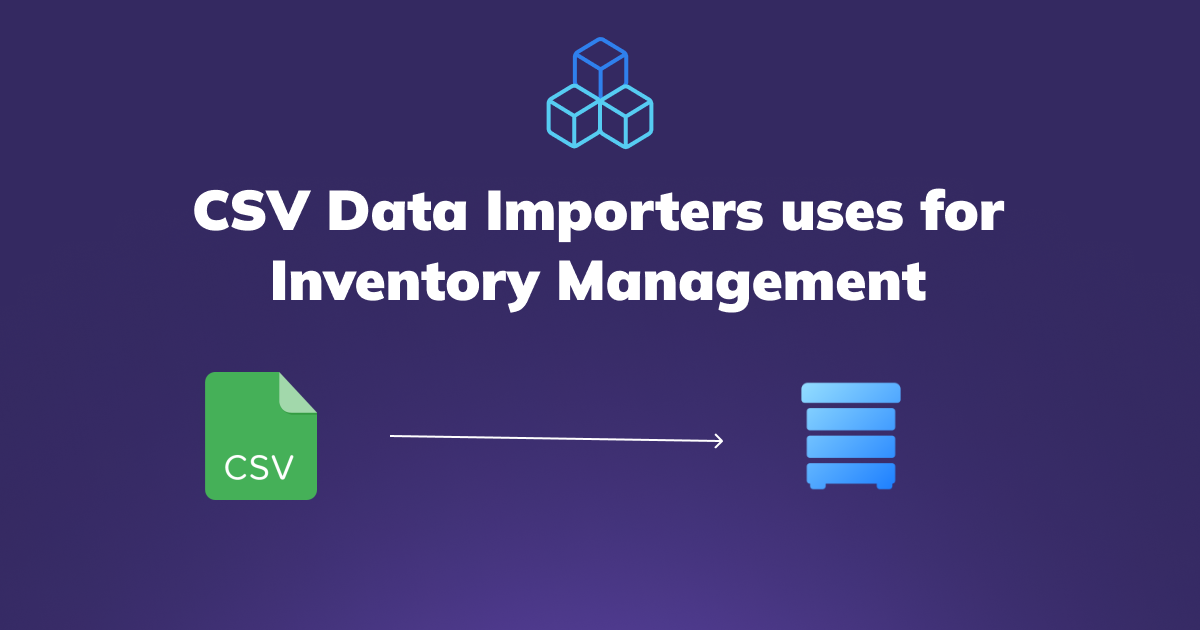Harnessing the Power of Embeddable CSV Data Importers in Inventory Management

In today's data-driven business world, effectively managing inventory is crucial for the success of any organization, whether it’s a small e-commerce store or a large-scale manufacturing enterprise. A well-managed inventory not only minimizes costs but also ensures that customer demand is consistently met.
One powerful tool that can greatly enhance inventory management is an embeddable CSV data importer.
This blog post will explore the transformative benefits, diverse applications, and implementation strategies of embeddable CSV data importers in inventory management.
Understanding CSV Files in Inventory Management
CSV (Comma Separated Values) files are a fundamental format for storing and exchanging data. These files contain data organized in a structured, tabular format where each line represents a row in the table, and each value is separated by a comma. The simplicity of CSV files makes them highly versatile and compatible with various software solutions.
Inventory management involves handling large volumes of data, including stock levels, order histories, supplier details, and more. Traditionally, managing such data required exporting and importing CSV files manually, which was time-consuming and prone to errors. This is where embeddable CSV data importers come into play.
What is an Embeddable CSV Data Importer?
An embeddable CSV data importer is a sophisticated tool or plugin that seamlessly integrates into your web or desktop application, enabling users to import, read, and manage CSV files directly within the application. It automates data import processes, ensuring that data from CSV files is accurately and efficiently ingested into the inventory management system.
These tools are designed for flexibility and customization, making them easy to integrate with various software environments. They facilitate rapid data ingestion, minimize the risk of errors, and ensure that the imported data is correctly formatted.
Key Features of Embeddable CSV Data Importers
Embeddable CSV data importers come with a range of features that make them indispensable in inventory management:
- Data Validation: They perform comprehensive checks to ensure that imported data is valid and error-free. Validation includes checking for required fields, data formats, and type consistency.
- Automated Data Mapping: These tools automatically map CSV columns to the corresponding fields in the inventory management system, reducing manual configuration and speeding up the import process.
- Scalability: Designed to handle large datasets efficiently, embeddable CSV data importers can manage substantial volumes of inventory data without compromising performance.
- Real-Time Processing: Many importers support real-time data processing, allowing immediate use of newly imported data for inventory tracking and decision-making.
- Error Handling and Logging: They provide detailed error reports and logging, enabling quick identification and correction of issues during the import process.
The Transformational Benefits of Inventory Management
Incorporating an embeddable CSV data importer into your inventory management system offers numerous transformative benefits:
- Increased Efficiency: Manual data entry and import processes are labour-intensive and time-consuming. Embeddable CSV data importers automate these processes, freeing up valuable time for inventory managers to focus on strategic tasks such as demand forecasting and order optimization.
- Enhanced Accuracy: Human errors in manual data entry can lead to inaccurate inventory records, affecting supply chain decisions and customer satisfaction. Automated importers ensure accurate data import, reducing the risk of errors and enhancing the reliability of inventory data.
- Real-Time Inventory Tracking: In the fast-paced world of inventory management, real-time data is critical. Embeddable CSV data importers enable real-time data import, ensuring that inventory records are always up-to-date and accurate, facilitating timely replenishment and inventory optimization.
- Improved Data Integration: Inventory management often involves data from multiple sources, such as suppliers, sales channels, and warehouses. Embeddable CSV data importers facilitate seamless data integration, creating a unified view of inventory data that supports comprehensive analysis and decision-making.
- Customizability: Embeddable CSV data importers can be tailored to meet specific business needs, allowing for customized data import processes that align with organizational requirements and workflows.
Applications of Embeddable CSV Data Importers in Inventory Management
Now, let’s explore some practical applications of embeddable CSV data importers in inventory management:
- Stock Level Updates: Keeping track of stock levels across multiple locations and sales channels is crucial for maintaining optimal inventory levels. With an embeddable CSV data importer, inventory managers can easily upload CSV files containing stock level data from different sources, ensuring that the inventory management system always reflects accurate stock levels.
- Order Fulfillment: For e-commerce businesses and retail operations, timely order fulfilment is essential for customer satisfaction. Embeddable CSV data importers can streamline the process of importing order data from various sales channels into the inventory management system. This ensures that order fulfilment processes are efficient and accurate, reducing the risk of stockouts and delayed shipments.
- Supplier Data Management: Managing supplier information, including contact details, lead times, and order histories, is vital for effective inventory management. Embeddable CSV data importers enable seamless integration of supplier data from CSV files into the inventory management system. This facilitates better supplier relationship management and more informed procurement decisions.
- Demand Forecasting: Accurate demand forecasting is crucial for inventory optimization. By using embeddable CSV data importers, inventory managers can effortlessly import historical sales data and other relevant factors from CSV files into forecasting models. This supports more accurate demand predictions, helping to reduce excess inventory and avoid stockouts.
- Product Information Management: Maintaining accurate and comprehensive product information is essential for inventory management. Embeddable CSV data importers allow for the easy import of product data, including descriptions, specifications, and pricing, into the inventory management system. This ensures that product information is always up-to-date and accurate across all sales channels.
- Inventory Audits: Periodic inventory audits are necessary to ensure that physical inventory matches system records. Embeddable CSV data importers can simplify the audit process by allowing inventory managers to upload CSV files containing audit data directly into the inventory management system. This facilitates quick and accurate reconciliation of discrepancies.
- Multi-Channel Inventory Management: Managing inventory across multiple sales channels, such as online stores, brick-and-mortar locations, and marketplaces, requires accurate and up-to-date data. Embeddable CSV data importers enable the seamless import of inventory data from various channels into a centralized inventory management system, ensuring a unified view and better control over multi-channel inventory.
Implementation Strategies for Inventory Managers
Implementing an embeddable CSV data importer into your inventory management workflow requires careful planning and execution. The following strategies can help ensure a smooth and successful implementation:
- Assess Your Requirements: Start by evaluating your specific data import needs. Consider the volume of data you handle, the frequency of data imports, and the types of information you need to manage. This assessment will help you choose an embeddable CSV data importer that aligns with your requirements.
- Choose the Right Importer: Various embeddable CSV data importers are available in the market, each offering different features and capabilities. Research and compare different options to find the one that best meets your needs. Factors to consider include ease of integration, scalability, data validation features, and support for real-time processing.
- Plan the Integration: Once you have selected an importer, carefully plan the integration process. Identify the data sources, target systems, and integration points. Define data mapping rules, validation criteria, and error-handling procedures. A well-planned integration minimizes potential disruptions and ensures a smooth transition.
- Test Extensively: Before deploying the importer in a production environment, conduct extensive testing. Test the import process with different types of CSV files and scenarios to ensure that the data is imported accurately and efficiently. Address any issues or gaps identified during testing to ensure a seamless import process.
- Train Your Team: Provide training to your inventory managers and relevant team members on how to use the embeddable CSV data importer effectively. Ensure that they understand the import process, data validation criteria, and error-handling procedures. Well-trained users can leverage the importer's features to their full potential and minimize errors.
- Monitor and Optimize: After deployment, continuously monitor the import process to ensure that it is functioning as expected. Collect feedback from users and address any issues promptly. Consider optimizing the importer configuration based on usage patterns and performance metrics to enhance efficiency and effectiveness.
Conclusion
Incorporating an embeddable CSV data importer into your inventory management system represents a significant step toward modernizing and optimizing data handling processes. These tools bring numerous benefits, including increased efficiency, enhanced accuracy, real-time inventory tracking, improved data integration, and customizability. Inventory managers can leverage embeddable CSV data importers for various applications, including stock level updates, order fulfilment, supplier data management, demand forecasting, product information management, inventory audits, and multi-channel inventory management.
By carefully assessing requirements, choosing the right importer, planning integration, testing extensively, training the team, and monitoring the process, inventory managers can ensure a successful implementation. Ultimately, embeddable CSV data importers empower inventory managers to harness the full potential of their data, leading to more informed decision-making and improved inventory control.
In today's rapidly evolving business environment, the ability to efficiently manage and analyze inventory data is paramount. As technology continues to advance, tools like embeddable CSV data importers will play an increasingly vital role in shaping the future of inventory management. Embrace the power of automation and data integration to unlock new levels of insight, efficiency, and success in your inventory management endeavours.

